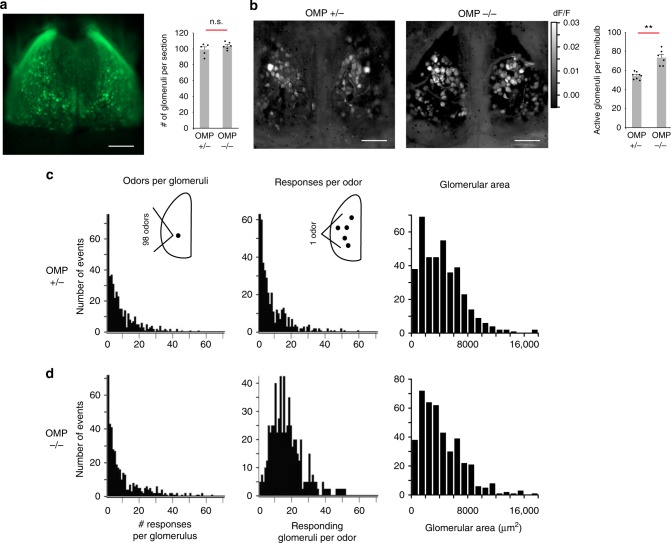Fig. 1.
Absence of OMP alters odor responses, but preserves macro-organization of the OB. a (Left) Widefield view of dorsal surface of an OMP+/– mouse shows labeled glomeruli from the resting fluorescence of spH. (Right) Quantification of the number of glomeruli per coronal section in central sections of the OB. Shown are 99 ± 3.44 glomeruli per coronal section for OMP+/- mice (mean ± SEM, n = 5 slices from 2 mice) and 104 ± 1.8 glomeruli per coronal section for OMP–/– (mean ± SEM, n = 6 slices from 2 mice). b (Left) Maximum projection glomerular odor response maps for exemplar OMP+/– and OMP–/– mice to a panel of 99 odorants. (Right) Average number of responsive glomeruli per hemibulb to the odor panel (Supplementary Table 1). Shown are 53.9 ± 1.3 glomeruli per hemibulb for OMP+/- mice (mean ± SEM, n = 8 hemibulbs) and 72.6 ± 3.3 glomeruli per hemibulb for OMP–/– (mean ± SEM, n = 6 hemibulbs). c, d (Left) Histograms of the number of odors to which a single glomerulus responds. (Center) Histograms of the number of glomeruli activated by an individual odor in the panel. (Right) Histograms of glomerular area in central coronal sections of the OB in OMP+/– and OMP–/– mice. n.s. indicates difference is not statistically significant, **p < 0.005, Kolmogorov–Smirnov test; scale bar, 500 μm

